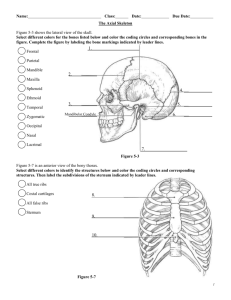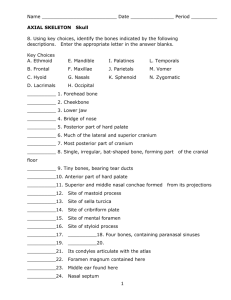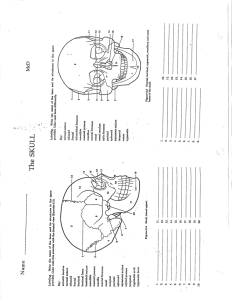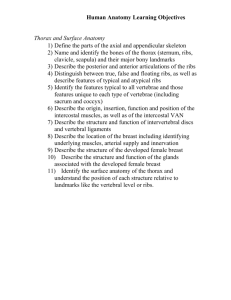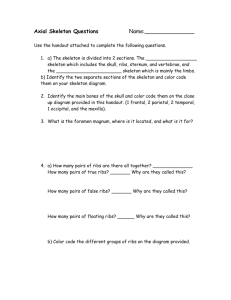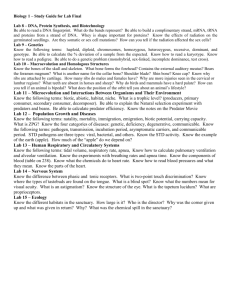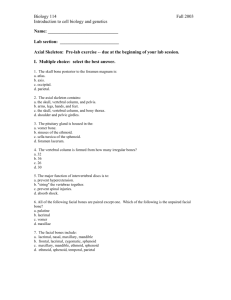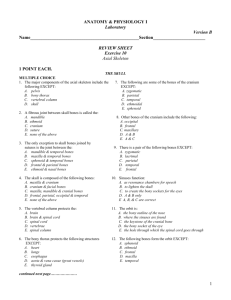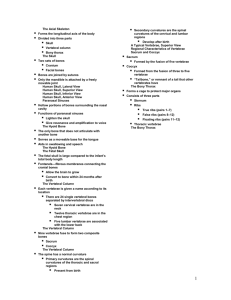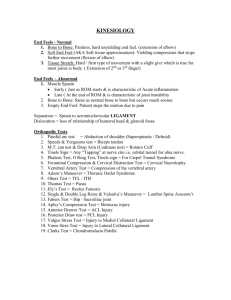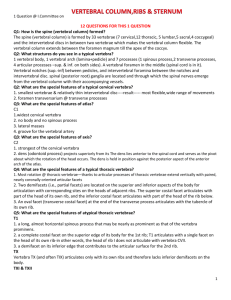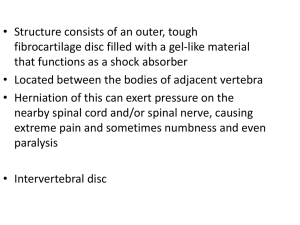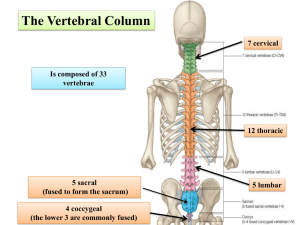axial skeleton - apcscience.com
advertisement
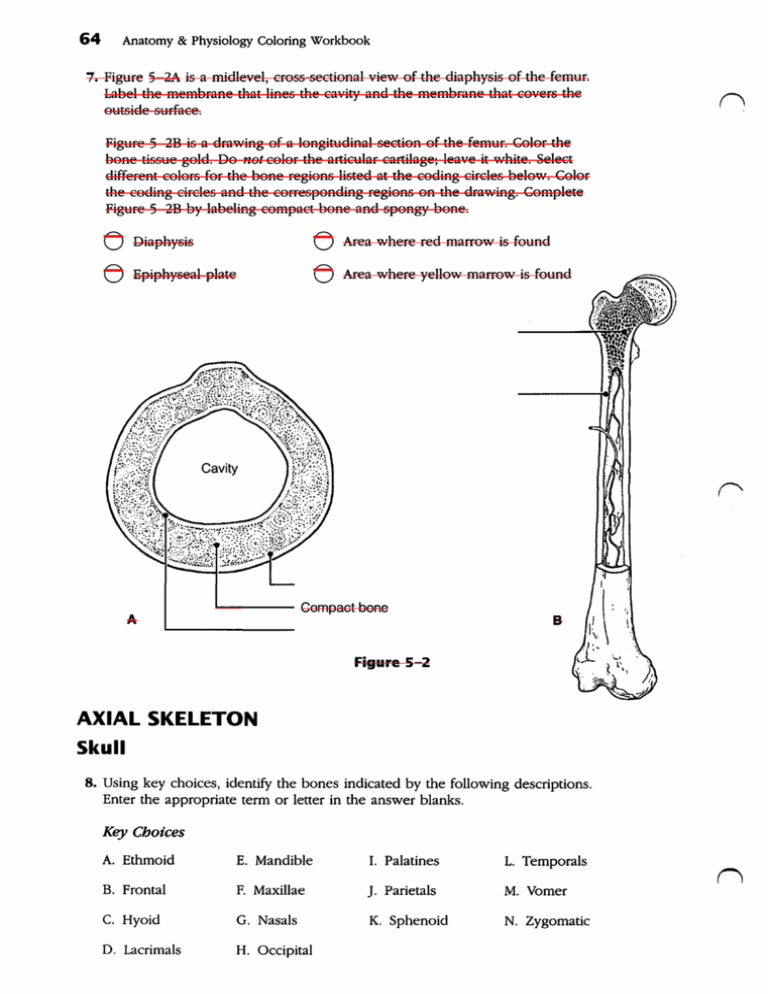
64 Anatomy & Physiology Coloring Workbook 7. Figure 5-2A is a midlevel, cross-sectional view of the diaphysis of the femur. Label the membrane that lines the cavity and the membrane that covers the outside surface. Figure 5-2B is a drawing of a longitudinal section of the femur. Color the bone tissue gold. Do not color the articular cartilage; leave it white. Select different colors for the bone regions listed at the coding circles below. Color the coding circles and the corresponding regions on the drawing. Complete Figure 5-2B by labeling compact bone and spongy bone. o o Area where red marrow is found o Area where yellow marrow is found Diaphysis o Epiphyseal plate ' " - - - - - - Compact bone A B Figure 5-2 AXIAL SKELETON Skull 8. Using key choices, identify the bones indicated by the follOWing descriptions. Enter the appropriate term or letter in the answer blanks. Key Choices A. Ethmoid E. Mandible I. Palatines L. Temporals B. Frontal F. Maxillae J. Parietals M. Vomer C. Hyoid G. Nasals K. Sphenoid N. Zygomatic D. Lacrimals H. Occipital Chapter 5 The Skeletal System 1. Forehead bone 2. Cheekbone 3. Lower jaw 4. Bridge of nose 5. Posterior part of hard palate 6. Much of the lateral and superior cranium 7. Most posterior part of cranium 8. Single, irregular, bat-shaped bone, forming part of the cranial floor 9. Tiny bones, bearing tear ducts _ _ _ _ _ _ _ _ _ _ 10. Anterior part of hard palate _ _ _ _ _ _ _ _ _ _ 11. Superior and middle nasal conchae formed from its projections _ _ _ _ _ _ _ _ _ _ 12. Site of mastoid process _ _ _ _ _ _ _ _ _ _ 13. Site of sella turcica _ _ _ _ _ _ _ _ _ _ 14. Site of cribriform plate _ _ _ _ _ _ _ _ _ _ 15. Site of mental foramen _ _ _ _ _ _ _ _ _ _ 16. Site of styloid process ___________ 17. ___________ 18. Four bones, con~ining paranasal sinuses _ _ _ _ _ _ _ _ _ 19. _ _ _ _ _ _ _ _ _ 20. ____________ 21. Its condyles articulate with the atlas ____________ 22. Foramen magnum contained here _ _ _ _ _ _ _ _ _ _ 23. Middle ear found here _ _ _ _ _ _ _ _ _ _ 24. Nasal septum _ _ _ _ _ _ _ _ _ _ 25. Bears an upward protrusion, the "cock's comb," or crista galli _ _ _ _ _ _ _ _ _ _ 26. Site of external acoustic meatus 65 66 Anatomy & Physiology Coloring Workbook 9. Figure 5-3, A-C shows lateral, anterior, and inferior views of the skull. Select different colors for the bones listed below and color the coding circles and corresponding bones in the figure. Complete the figure by labeling the bone markings indicated by leader lines. 0 0 0 0 Frontal Parietal Mandible 0 0 0 Sphenoid Ethmoid Temporal 0 0 0 0 0 0 Zygomatic Palatine OCcipital Maxilla . ~. I , " /' 1/11", ,\ 'I. I '/ A Figure 5-3, A-C Nasal Lacrimal Vomer Chapter 5 The Skeletal System B c 67 68 Anatomy & Physiology Coloring Workbook 10. An anterior view of the skull, showing the positions of the sinuses, is provided in Figure 5-4. First select different colors for each of the sinuses and use them to color the coding circles and the corresponding structures on the figure. Then briefly answer the following questions concerning the sinuses. 1. VVhataresinuses? ____________________________________________________________ 2. VVhat purpose do they serve in the skull? _ _ _ _ _ _ _ _ _ _ _ _ _ _ _ _ _ __ 3. VVhy are they so susceptible to infection? ______________________________________ o o Ethmoid sinuses o Maxillary sinus Sphenoid sinus o Frontal sinus Figure 5-4 Chapter 5 The Skeletal System 69 Vertebral Column 11. Using the key choices, correcdy identify the vertebral parts/areas described as follows. Enter the appropriate term(s) or letterCs) in the spaces provided. Key Choices A. Body C. Spinous process E. Transverse process B. Intervertebral foramina D. Superior articular process F. Vertebral arch 1. Structure that encloses the nerve cord 2. Weight-bearing portion of the vertebra 3. Provide(s) levers for the muscles to pull against 4. Provide(s) an articulation point for the ribs s. Openings providing for exit of spinal nerves 12. The following statements provide distinguishing characteristics of the vertebrae composing the vertebral column. Using key choices, identify each described structure or region by inserting the appropriate term(s) or letterCs) in the spaces provided. Key Choices A. Atlas D. Coccyx F. Sacrum B. Axis E. Lumbar vertebra G. Thoracic vertebra C. Cervical vertebra-typical 1. Type of vertebra(e) containing foramina in the transverse processes, through which the vertebral arteries ascend to reach the brain 2. Its dens provides a pivot for rotation of the first cervical vertebra 3. Transverse processes have facets for articulation with ribs; spinous process points sharply downward 4. Composite bone; articulates with the hip bone laterally S. Massive vertebrae; weight-sustaining 6. Tailbone; vestigal fused vertebrae 7. Supports the head; allows the rocking motion of the occipital condyles _ _ _ _ _ _ _ _ _ _ 8. Seven components; unfused _ _ _ _ _ _ _ _ _ _ 9. Twelve components; unfused 70 Anatomy & Physiology Coloring Workbook 13. Complete the following statements by inserting your answers in the answer blanks. 1. 2. 3. In describing abnormal curvatures, it could be said that -.J!L is an exaggerated thoracic curvature, and in ~ the vertebral column is displaced laterally. Invertebral discs are made of ~ tissue. The discs provide ~ to the spinal column. 4. 14. Figure 5-5, A-D shows superior views of four types of vertebrae. In the spaces provided below each vertebra, indicate in which region of the spinal column it would be found. In addition, specifically identify Figure 5-5A. Where indicated by leader lines, identify the vertebral body, spinous and transverse processes, superior articular processes, and vertebral foramen. A ___________________ B ___________________ c ___________________ 0 ____________________ Figure 5-5 Chapter 5 The Skeletal System 15. Figure 5-6 is a lateral view of the vertebral column. Identify each numbered region of the column by listing in the numbered answer blanks the region name first and then the specific vertebrae involved (for example, sacral region, S# to S#). Also identify the modified vertebrae indicated by numbers 6 and 7 in Figure 5-6. Select different colors for each vertebral region and use them to color the coding circles and the corresponding regions. 6~ 7 1. 2. 3. 4. 5. 6. 7. ..., 0 0 0 0 0 0 0 2 Figure 5-6 71 72 Anatomy & Physiology Coloring Workbook Bony Thorax 16. Complete the following statements referring to the bony thorax by inserting your responses in the answer blanks. 1. 2. 3. The organs protected by the thoracic cage include the -.i!L and the ~. Ribs 1 through 7 are called ~ ribs, whereas ribs 8 through 12 are called ~ ribs. Ribs 11 and 12 are also called ~ ribs. All ribs articulate posteriorly with the ~ and most connect anteriorly to the ~ either directly or indirectly. 4. The general shape of the thoracic cage is ~. 5. 6. 7. 8. 17. Figure 5-7 is an anterior view of the bony thorax. Select different colors to identify the structures below and color the coding circles and corresponding structures. Then label the subdivisions of the sternum indicated by leader lines. o o All true ribs o All false ribs Costal cartilages o Sternum Figure 5-7

